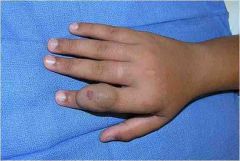![]()
![]()
![]()
Use LEFT and RIGHT arrow keys to navigate between flashcards;
Use UP and DOWN arrow keys to flip the card;
H to show hint;
A reads text to speech;
15 Cards in this Set
- Front
- Back
- 3rd side (hint)
|
Which syndrome? Enchondromatosis associated with multiple cutaneous hemangiomas. |
Maffucci syndrome is associated with venous malformations and multiple enchondromas. It can be associated with malignant chondrosarcomas, and intracranial tumors occur in 20% of patients. |
|
|
|
Which disease? Hemangiomas of the retina Hemangioblastomas of the cerebellum Commonly associated with cysts of the pancreas, liver, adrenal glands, and kidney Can have seizures & DD |
Von Hippel Lindau |
Large facial hemangiomas |
|
|
What does PHACE stand for? |
posterior fossa malformations hemangiomas arterial anomalies coarctation of the aorta/cardiac defects eye abnormalities |
|
|
|
Which vascular tumor has a 50% association with Kasabach-Merritt phenomenon? |
Profound thrombocytopenia with kaposiform hemangioendothelioma |
|
|
|
Vascular malformations: What causes them? When do they appear? |
Faulty embryonic morphogenesis Present at birth, grow proportionately with the child, and do not regress, unlike hemangiomas |
|
|
|
What is this called? Capillary malformation most commonly seen on the face in trigeminal nerve distribution. Which syndrome might someone have? 2 lasers used to treat it? |
- Port Wine stain -Sturge-Weber syndrome: Sometimes accompanied by ocular and central nervous system disorders - Photocoagulation with pulsed dye laser (585 nm) and/or Nd:YAG laser |
|
|
|
Syndrome? Patchy port-wine stain on an extremity overlying a deeper venous and lymphatic malformation with associated skeletal hypertrophy. What if the person also has a component of AV malformation? |
Klippel-Trénaunay syndrome Parkes Weber syndrome |
|
|
|
When AVMs are resected, what should be done preop? What type of margin? Two scariest complications? |
Preoperative embolization followed by surgical resection within 72 hours ▀Wide local excision because recurrence rates are very high - CHF, consumptive coagulopathy |
|
|
|
Which vascular malformation can be hormone sensitive? |
Venous malformations swell in the dependent position and can be hormone sensitive. |
|
|

12-year-old boy has had the lesion of the right index finger shown in the photograph since birth. The lesion has been growing in proportion to his overall growth. On physical examination, there is no thrill or bruit. Malformation? |
Lymphatic malformation, because it's growing in proportion & therefor isn't behaving like a hemangioma. |
|
|
|
First-line treatment of a small problematic infantile hemangioma? |
Injection of steroid. |
Only happens in 66% |
|
|
7-year-old boy is evaluated because of capillary malformations in the right leg and thigh, which have been present since birth. Physical examination shows venous varicosities over the anterior leg and medial thigh. Girth of the affected lower limb is increased compared with the unaffected limb. Duplex imaging discloses no sign of arteriovenous fistulae. This patient is at greatest risk for which other problem? |
The presence of capillary malformations, varicosities, and limb hypertrophy paired with the absence of arteriovenous (AV) fistulae is classic for Klippel-Trénaunay syndrome. Up to 67% of patients with Klippel-Trénaunay syndrome will exhibit limb-length discrepancy, most commonly with the affected limb being hypertrophic. |
|
|
|
Which factor is most associated with high risk of recurrence in AVMs? |
Ulceration |
|
|
|
First-line intervention for a large symptomatic venous malformation is ? First-line treatment for an AVM? |
sclerotherapy (then resection as second-line) Embolization for AVMs |
|
|
|
First line treatment for Kaposiform endothelioma? |
Vincristine is considered first-line therapy and has supplanted interferon alfa-2a due to its efficacy and decreased risk of major side effects. |
|

